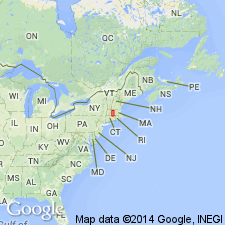
- Usage in publication:
-
- Poplar Mountain Gneiss*
- Modifications:
-
- Overview
- AAPG geologic province:
-
- New England province
Summary:
Used as Poplar Mountain Gneiss of Proterozoic Z age. Probably correlates with Mount Mineral Formation but is more feldspathic. Divided into dark biotite gneiss and beds of quartzite, biotite gneiss, and basal quartzite where thick enough to map separately. Mapped undivided with Dry Hill Gneiss in places.
Source: GNU records (USGS DDS-6; Reston GNULEX).

- Usage in publication:
-
- Poplar Mountain Gneiss*
- Modifications:
-
- Overview
- Age modified
- AAPG geologic province:
-
- New England province
Summary:
Name was applied by Balk (1956) to distinctive gray quartz-biotite-microcline gneisses formerly assigned to Pelham Granite (Emerson, 1917). Was subdivided by Ashenden (1973) into a basal quartzite member and a gneiss member. In area of exposure near Poplar Mountain, formation lies in core of Pelham dome, structurally beneath Dry Hill Gneiss. There, quartzite member occurs continuously near contact with Dry Hill Gneiss, as shown by Zen (1983, State geologic map). Second area of Poplar Mountain Gneiss occurs in thin layer that lies structurally above Dry Hill Gneiss. In that area, quartzite member occurs along contact with Dry Hill Gneiss, although quartzite member is too thin to map separately. Ashenden's (1973) structural interpretation is that Dry Hill Gneiss occupies core of recumbent anticlinal nappe in which one Poplar Mountain sequence with basal quartzite is right side up on top limb and another sequence with basal quartzite is upside down on bottom limb. Poplar Mountain on top limb appears to grade southward along strike into Mount Mineral Formation. Inverted basal quartzite on bottom limb plunges beneath surface south of Millers River, but reappears in a window southwest of Dry Hill and possibly again in a small window exposed in a brook northwest of Mount Lincoln in Pelham. Because Poplar Mountain Gneiss grades into Dry Hill Gneiss, because layers Dry Hill-like gneiss occur within Poplar Mountain Gneiss, and because Dry Hill Gneiss contains many quartzite beds, age of Poplar Mountain Gneiss is considered Late Proterozoic.
Source: GNU records (USGS DDS-6; Reston GNULEX).
For more information, please contact Nancy Stamm, Geologic Names Committee Secretary.
Asterisk (*) indicates published by U.S. Geological Survey authors.
"No current usage" (†) implies that a name has been abandoned or has fallen into disuse. Former usage and, if known, replacement name given in parentheses ( ).
Slash (/) indicates name conflicts with nomenclatural guidelines (CSN, 1933; ACSN, 1961, 1970; NACSN, 1983, 2005, 2021). May be explained within brackets ([ ]).

